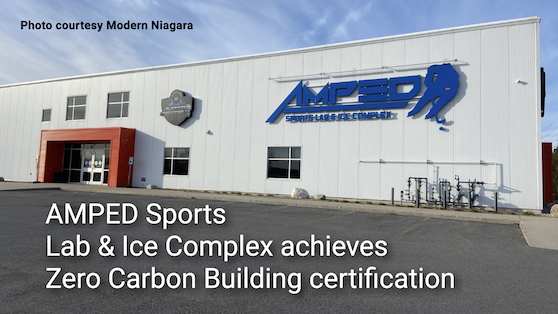
Features
Institutional
News
Ottawa’s AMPED arena converted to Zero Carbon Building
Modern Niagara converts the AMPED Sports Lab and Ice Complex into the first CaGBC Zero Carbon Building – Performance Standard certified arena.
February 24, 2021 By Energy Manager Canada

February 24, 2021 – Modern Niagara, a national mechanical, electrical and integrated building technology contractor, has converted the AMPED Sports Lab and Ice Complex in Ottawa into North America’s first arena to be Zero Carbon Building-certified. The project achieved its certification in December 2020 through the Canada Green Building Council’s (CaGBC) Zero Carbon Building Program.
“We believe that what we accomplished at AMPED Sports Lab and Ice Complex represents a step in the right direction towards building a more sustainable future,” said Brad McAninch, CEO of Modern Niagara Group. “While converting AMPED into the world’s first arena to achieve the Zero Carbon Building Performance Standard certification did not come without challenges, I see this achievement as a great opportunity for Canada’s infrastructure more generally.”
All fossil fuel consumption related to building energy use was eliminated onsite and converted to electric-based alternatives. Custom-designed and -built rooftop units were manufactured with heat pumps and electric heat backup instead of the traditional direct expansion (DX) coil and gas-fired burner to achieve the goal.
Also, the arena dehumidification system was retrofitted with a custom-built, liquid dessicant air-conditioned unit, equipped with refrigeration DX system reheat. These custom units provided the highest possible efficiency while helping to reduce GHG emissions. Also, the gas-fired domestic water heaters were replaced with heat pump water heaters.
To better manage building performance, including the ice-making process, an automation and metering system was installed. Used in combination with a real-time analytics software package, it optimizes building and process control and performance, enhances maintenance services, and assists in the continuous commissioning of the facility to ensure energy savings persist.
The chiller system used to make ice for the rink also had an energy optimization automation system installed to ensure run-times and sequencing are automatically adjusted to drive efficiencies. Heat reclaim from the ammonia-based chiller was considered; however, the ROI was excessive for the low amount of high-temperature heat available.
The lighting systems were also retrofitted to high-efficiency LED, and a 136-kW solar photovoltaic array was installed.
Print this page
